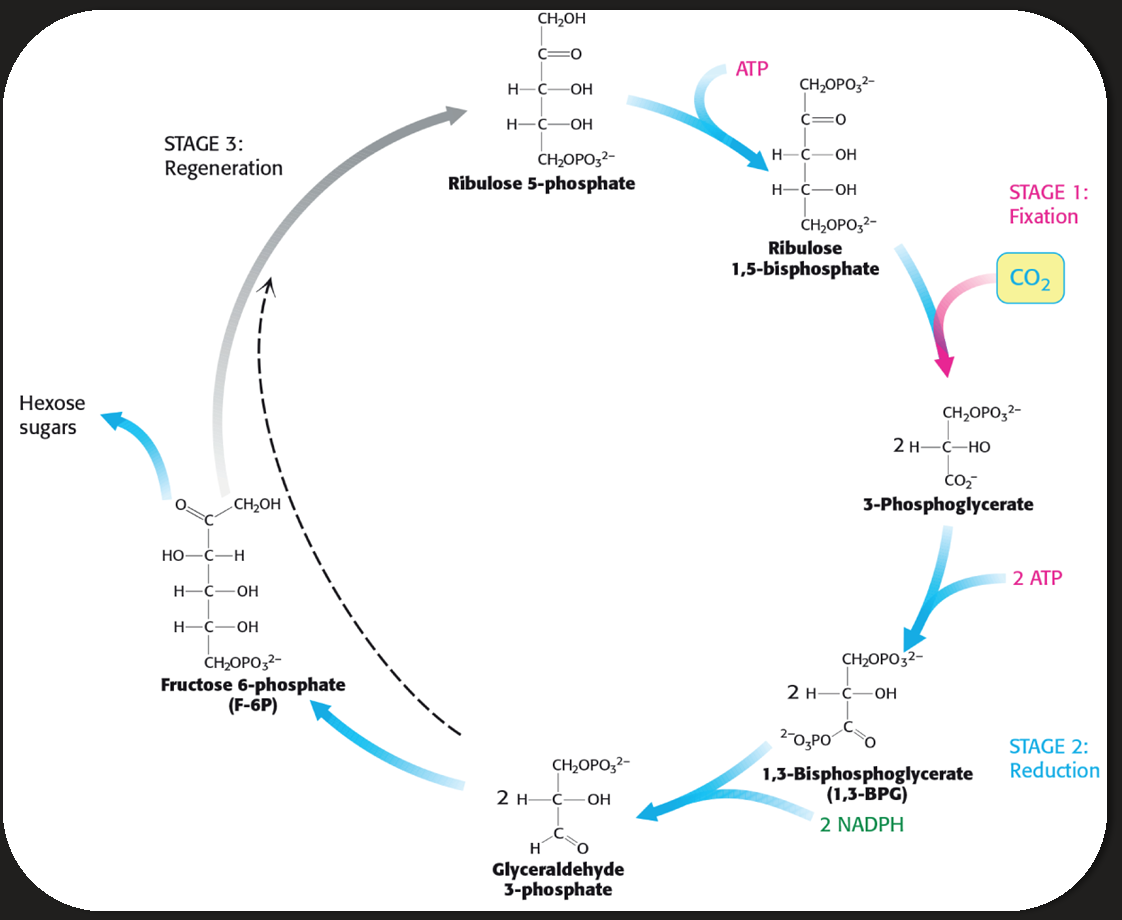Photosynthesis
🌞 Overview
Photosynthesis is a two-stage process in which cells convert light energy into chemical energy, ultimately synthesizing organic molecules (e.g., glucose).
Stage 1: Light-dependent reactions (in thylakoid membranes)
Stage 2: Light-independent reactions / Calvin Cycle (in the stroma)
🌿 Stage 1: Light-Dependent Reactions (The Light Reactions)
📍 Where It Happens:
Location: Thylakoid membranes of the chloroplast
⚡ Purpose:
Convert light energy into ATP and NADPH
Split water molecules (H₂O) to release O₂ and protons
Build a proton gradient to drive ATP synthesis
🔋 Key Processes of the Light Reactions
1. Photon Absorption & Electron Excitation
Chlorophyll a, the principal photoreceptor in green plants, absorbs light.
Light excites electrons in pigment molecules to higher energy states.
Excited electrons are transferred to nearby electron acceptors.
2. Photosystem II (PSII)
Reaction center: P680
Function: Splits water (photolysis), releasing:
Electrons (to replace those lost by chlorophyll)
Protons (into the thylakoid lumen)
Oxygen (as a byproduct)
Initiates electron transport chain to Photosystem I
3. Electron Transport & Proton Pumping
Electrons travel through the cytochrome b₆f complex.
Protons are pumped from the stroma into the thylakoid lumen.
This creates a proton gradient (high H⁺ in lumen, low in stroma).
4. Photosystem I (PSI)
Reaction center: P700
Absorbs another photon of light → excites electrons again.
Electrons are passed to ferredoxin, then to ferredoxin-NADP⁺ reductase, reducing NADP⁺ to NADPH.
5. ATP Synthesis
ATP synthase uses the proton gradient to generate ATP (photophosphorylation).
ATP and NADPH are both produced on the stromal side of the membrane.
🔁 Optional: Cyclic Photophosphorylation
If NADPH is abundant, PSI can cycle electrons back to cytochrome bf.
Produces ATP without making NADPH or O₂.
Useful when more ATP is needed relative to NADPH.
🎨 Accessory Pigments & Protection
Chlorophyll b, carotenoids (e.g., β-carotene) help capture light and funnel energy to reaction centers.
Also serve a protective role, using non-photochemical quenching (NPQ) to safely dissipate excess light energy as heat.
Prevent formation of reactive oxygen species (ROS), which can damage cells.
☠ Herbicides and Inhibition
Diuron, atrazine: block Photosystem II
Paraquat: disrupts Photosystem I, causes ROS buildup
🧬 Evolution and Endosymbiosis
Chloroplasts originated from cyanobacteria via endosymbiosis.
Chloroplasts contain DNA but depend on nuclear-encoded proteins.
Photosynthesis evolved ~2 billion years ago in bacteria (no archaea perform it).
🌱 Stage 2: Light-Independent Reactions (Calvin Cycle)
📍 Where It Happens:
Location: Stroma of the chloroplast
🎯 Purpose:
Use ATP and NADPH from the light reactions to convert CO₂ into glucose
🔄 The Calvin Cycle: 3 Stages
1. Carbon Fixation
Enzyme RuBisCO attaches CO₂ to ribulose-1,5-bisphosphate (RuBP)
Produces two molecules of 3-phosphoglycerate (3-PGA)
2. Reduction
ATP and NADPH reduce 3-PGA to glyceraldehyde-3-phosphate (G3P)
G3P is the precursor to glucose and other carbohydrates
3. Regeneration
Some G3P is used to regenerate RuBP, allowing the cycle to continue
🧬 Structural Components of Photosynthesis
🌳 Chloroplast Structure:
Double membrane organelle
Stroma: Site of Calvin Cycle
Thylakoid membranes: Site of light reactions
Contain photosystems, ATP synthase, electron transport chains
🔌 Electron Flow Summary (Linear Pathway)
H₂O → PSII → Cyt b₆f → PSI → Ferredoxin → NADP⁺ → NADPH
This flow:
Generates O₂
Builds proton gradient → drives ATP synthesis
Reduces NADP⁺ to NADPH
🔁 Photosynthesis vs. Cellular Respiration
Feature | Photosynthesis | Cellular Respiration |
|---|---|---|
Organelle | Chloroplast | Mitochondrion |
Energy source | Light | Chemical (glucose) |
Electron flow | H₂O → NADP⁺ | Glucose → O₂ |
ATP site | Stroma | Matrix |
H⁺ gradient | Into thylakoid lumen | Into intermembrane space |
Byproduct | O₂ | CO₂ |
